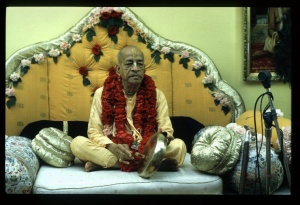CC Adi 2.114 (1975)

A.C. Bhaktivedanta Swami Prabhupada
Below is the 1996 edition text, ready to be substituted with the 1975 one using the compile form.
TEXT 114
- keho kahe, kṛṣṇa kṣīroda-śāyī avatāra
- asambhava nahe, satya vacana sabāra
SYNONYMS
keho—someone; kahe—says; kṛṣṇa—Lord Kṛṣṇa; kṣīroda-śāyī—Kṣīrodakaśāyī Viṣṇu; avatāra—incarnation; asambhava—impossible; nahe—is not; satya—true; vacana—speeches; sabāra—of all.
TRANSLATION
Some say that Kṛṣṇa is the incarnation of Kṣīrodakaśāyī Viṣṇu. None of these statements is impossible; each is as correct as the others.
PURPORT
The Laghu-bhāgavatāmṛta (5.383) states:
- ata evā purāṇādau kecin nara-sakhātmatām
- mahendrānujatāṁ kecit kecit kṣīrābdhi-śāyitām
- sahasra-śīrṣatāṁ kecit kecid vaikuṇṭha-nāthatām
- brūyuḥ kṛṣṇasya munayas tat-tad-vṛtty-anugāminaḥ
“According to the intimate relationships between Śrī Kṛṣṇa, the primeval Lord, and His devotees, the Purāṇas describe Him by various names. Sometimes He is called Nārāyaṇa; sometimes Upendra (Vāmana), the younger brother of Indra, King of heaven; and sometimes Kṣīrodakaśāyī Viṣṇu. Sometimes He is called the thousand-hooded Śeṣa Nāga, and sometimes the Lord of Vaikuṇṭha.”